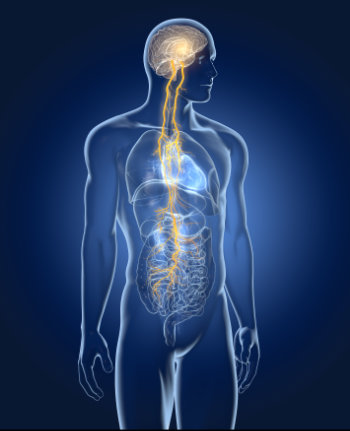
Vagus nerve
- Vagus nerve is cranial (head) nerve #10 exiting from the right and left posterior sides of the skull
- Vagus nerve goes to various organs and structures in the chest, abdomen, head, and throat
Scenarios with low vagal tone – they cause and/or promote ill health
- Pain and inflammation
- Migraine headaches
- Respiratory distress
- Covid, Covid recovery, and Long-Haul Covid
- Gut sensitivities
- Gut dysbiosis with the presence of bacteria, viruses, yeast, parasites, or worms
- Poor detoxification
- Autoimmune disorders (i.e., rheumatoid arthritis and allergies)
- Persistent postural-perceptual dizziness (PPPD)
- Depression and anxiety
- Brain fog
- Difficulty swallowing or speaking
- Toxic mold exposure
- Concussion, any traumatic brain injury, and stroke recovery
- Experiencing or having a difficult time dealing with emotional or psychological stress
Understanding the cause of low vagal tone
Stress is the ultimate cause of low vagal tone. Stress can be mental (i.e., going through a divorce or having financial problems), physical (i.e., having surgical and/or trauma scars, not getting adequate sleep, working too many hours, or dealing with an injury or illness), chemical (i.e., taking prescription or over-the-counter medications, and exposure to environmental pollution from pesticides and herbicides in our fruits and vegetables and from automobile emissions).
Stress can produce an overstimulation of the sympathetic nervous system (SNS). Prolonged upregulation of the SNS can overpower the parasympathetic nervous system (PNS) which includes the Vagus nerve. In some instances, the upregulation of the SNS will produce a “fight-or-flight” adrenaline response such as an increase in blood pressure and pulse rate.
SNS stress is the “gas pedal” of the body and is only designed for short-term survival. Prolonged exposure to stress and the upregulation of the SNS will lead to a decrease in vagal tone.
The PNS is the “brake” of the body which slows us down when danger is not present and controls our digestion, detoxification, and immunologic balance. Eighty (80%) percent of this restoration response mediates through the Vagus nerve.
Achieving high vagal tone
 Achieving high Vagal tone is possible through non-invasive and pain-free microcurrent (small amounts of electrical stimulation) sessions applied to the auricular (ear) branches of the right and left Vagus nerves.
Achieving high Vagal tone is possible through non-invasive and pain-free microcurrent (small amounts of electrical stimulation) sessions applied to the auricular (ear) branches of the right and left Vagus nerves.
Learn more about Vagus nerve stimulation at https://www.dolphinmps.com/what-is-vagus-nerve/
